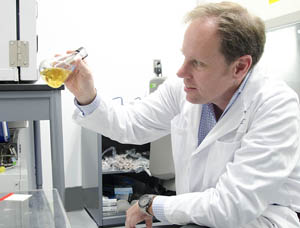
Breadcrumb
- News and Events
- News
- Content
- Interview with Dr. Don Sheppard
null Interview with Dr. Don Sheppard
|
FACE TO FACE with Dr. Don Sheppard: Breaking the mould to develop novel therapies against fungal infections - Director, Division of Infectious Diseases, McGill University Health Centre - Professor, Departments of Medicine and of Microbiology and Immunology, Faculty of Medicine, McGill University |
 |
|
Below is an interview with an RI-MUHC researcher who is truly a global citizen of science, in tune with the organisms he studies.
Don Sheppard: It’s called microbial glycomics, which refers to the study of sugar molecules. Our laboratory studies the structure of polysaccharides (sugar molecules) that prevent drugs from reaching their targets inside microorganisms. We recently discovered that sugars secreted by fungi act as a glue to help them attach to human lung cells and hide from the immune system during lung infections. I had never heard of glycomics when I started working as a molecular biologist. Now, it’s what I do. You’ve said that biofilm-forming organisms like fungi cause up to 70% of hospital-acquired infections. What are these sugar molecules, and why are they so important in infectious disease? D.S.: We work on two of the most common organisms that cause lung infections: Pseudomonas aeruginosa and Aspergillus fumigatus. Both grow within extracellular matrix called a biofilm as part of their infectious process, either immobilized on medical devices, like catheters, or directly in our tissues. These biofilms provide disease-causing organisms with a protective barrier, rendering them resistant to our immune defences or antimicrobials. A lot of failures and a lot of reasons why patients die when they’re on antibiotics is simply because we can’t get the drug where it needs to go in the bug. What are you doing to combat these biofilms? D.S.: We’ve figured out the machinery that these organisms use to make biofilms, which are mostly made up of long sugar molecules. Buried within this machinery is an enzyme capable of snipping these sugar molecules into bits, which the organism uses to move sugar molecules around, and control their length and location. We have stripped that enzyme of its regulatory controls, and made a soluble version that destroys the sugar molecule making up the biofilm. Essentially, we’re using the organism’s own machinery against itself, using it out of context and without its normal safeguards, so it will just chew up anything in its path, which, in this case, is the biofilm. How does the RI-MUHC’s Drug Discovery Platform help you do this? D.S.: The MALDI system is our workhorse tool for looking at what happens to biofilms when we treat them with these therapeutic enzymes. We grow the biofilms in test tubes or plates as though they were in the lungs, then add the therapeutic enzymes and look at what pieces of sugars come off. The MALDI tells us what chunks of sugar molecules are being released by these enzymes to allow us to set their activity, both quantitatively (how much is coming off) and qualitatively (what is being cut). How far away are you from human testing of these enzymes? D.S.: Our proof of concept studies are complete, which showed on the first attempt that this enzyme treatment is not toxic but also protected mice from fungal infection. To get a blockbuster result like this on the very first try was so surprising we actually threw out all our stocks and made a new batch of enzymes from scratch to rule out any contamination. Fortunately, we came up with exactly the same result. We’re now moving to the next stage to show that this treatment works against established infection in mouse models. Although we’re still a few years away from human testing, our success to date puts us on the right path. Using the organism’s own enzymes against itself is one of multiple strategies in varying stages of development in your lab. Tell me about the others. D.S.: Optimizing the use of existing antifungal drugs in completely novel ways and creating a synthetic vaccine that protects against these lethal fungi are among other approaches that have shown promising results in animal models of infection. You have been a physician since 1993 and a researcher since 2004. What motivated you to marry your clinical work with science? D.S.: The thing that bothers me the most is to watch someone whose cancer has been cured or whose bone marrow transplant has been working, dying of a fungus eating away at their lungs. I know what they have and I’m giving them a drug that I think should be working but it doesn’t do anything. I want to have another arrow in my quiver that can restore the activity of these drugs or can make them do what they’re supposed to, in order to make the patient better. From running a successful lab and seeing patients, to teaching and directing the Division of Infectious Diseases – you wear many hats. Why? D.S.: It all comes back to the same thing – if you want new discoveries to improve the health of patients, you can’t just do science, you can’t just do medicine and you can’t just be a health care administrator. You need to develop new therapies, figure out how to integrate them into our health care system, and then actually give them to patients.
─ May 2017 |